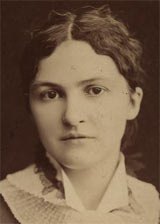Notice to Tramps: Labor Day and the homeless
Lazarus House, my charity running partner, was founded partly in response to proposed local ordinances that would make it illegal to feed a homeless person. Recently, we have seen a dramatic increase in number of such local laws, and it's troubling. It's important to speak against these wherever they occur; they don't address the issue of homelessness, they do nothing but force the homeless into hiding.
 It's not the first time such a "solution" has been entertained in our suburban communities. Lizzie Swank Holmes, a labor organizer and writer who lived in Geneva, was writing about it back in 1886, right before she was arrested for agitating for workers' rights.
It's not the first time such a "solution" has been entertained in our suburban communities. Lizzie Swank Holmes, a labor organizer and writer who lived in Geneva, was writing about it back in 1886, right before she was arrested for agitating for workers' rights.
Lizzie Holmes and her colleague Lucy Parsons were witnesses at the Haymarket Riot trial in 1886; shortly after, Lucy's husband Albert Parsons was hanged for his involvement in the Haymarket Riot.
Lizzie co-produced and both Lizzie and Lucy wrote for The Alarm, a Chicago labor and anarchist newspaper, one of the papers at the forefront of the movement to adopt an eight hour work day. On April 24, 1886, Lizzie wrote a short piece, Notice to Tramps:
In a beautiful town, not far from Chicago, lives a large class of cultivated, well-informed people. They have Shakespeare, Lowell, Longfellow and Whittier at their tongues’ ends, and are posted in history and grow enthusiastic over the wickedness of the safely abolished institutions of the past. They say eloquent things about old fugitive slave laws, etc., which make it criminal to feed and shelter a starving human being if he were black. Posted at the roadside, in the hotels and stores, is a ‘Notice to Tramps,’ an abominable document which compares well with the old notices to runaway negroes which used to deface similar buildings. It is against the law to feed a tramp. You are liable to a fine if you give a cup of coffee and a piece of bread to a fellow-man who needs it and asks you for it. This is a Christian community, under the flag of the free. Look out, you wretched slaves. If, after toiling through your best years, you are suddenly thrown out of a job along with thousands of others, do not start out to hunt for work, for you will strike plenty of such towns as this. You must not walk from town to town. You must not stay where you are in idleness - you must move on. You must not ride - you have no money, and those tracks and cars you helped to build are not for such as you. You must not ask for anything to eat, or a place to sleep. You must not lie down and die, for then you would shock peoples’ morals. What are you to do? Great heavens! Jump into the lake? Fly up into the air? Or stay - have you a match about you?
We must not let history repeat itself. People who work for a living should be able to make enough to eat and house themselves. Feeding the homeless must not be criminalized. Our hard fought social safety nets must be preserved.
Our community's proud history includes stops on the Underground Railroad as well as abolitionist and labor organizers. Lizzie and Lucy saw that fair labor laws were the foundation to a just society, one that supports the basic rights and dignity of every person in our community.
As we enjoy our Labor Day rest, we must remember that this rest was hard fought and hard won, and only came because locals like Lizzie Swank Holmes spoke up.

